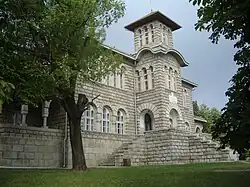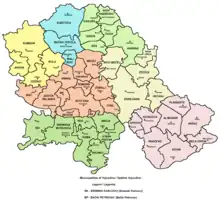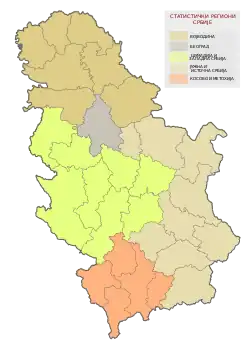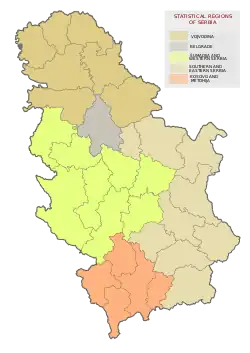Aranđelovac
| |
|---|---|
Town and municipality | |
 Aranđelovac- collage of image (Prince Mihailo's summer residence, The Main Square in Aranđelovac, Orthodox Church of the Holy Apostles Peter and Paul in Aranđelovac, Monument of Karađorđe in front of school in Orašac near Aranđelovac, Monument of sphinx in the park of Bukovička Banja, Hotel Izvor) | |
 Coat of arms | |
 Location of the municipality of Aranđelovac within Serbia | |
| Coordinates: 44°18′N 20°34′E / 44.300°N 20.567°E | |
| Country | |
| Region | Šumadija and Western Serbia |
| District | Šumadija |
| Settlements | 19 |
| Government | |
| • Mayor | Bojan Radović (SNS) |
| Area | |
| • Town | 8.43 km2 (3.25 sq mi) |
| • Municipality | 375.69 km2 (145.05 sq mi) |
| Elevation | 257 m (843 ft) |
| Population (2011 census)[2] | |
| • Town | 24,797 |
| • Town density | 2,900/km2 (7,600/sq mi) |
| • Municipality | 46,225 |
| • Municipality density | 120/km2 (320/sq mi) |
| Time zone | UTC+1 (CET) |
| • Summer (DST) | UTC+2 (CEST) |
| Postal code | 34300 |
| Area code | +381(0)34 |
| Car plates | AR |
| Website | www |
Aranđelovac (Serbian Cyrillic: Аранђеловац, pronounced [ǎraːndʑeloʋats] ⓘ) is a town and a municipality located in the Šumadija District of central Serbia. As of 2011, the municipality has a population of 46,225 inhabitants, while the town has 24,797 inhabitants.
It is situated beneath the mountains Bukulja and Venčac,[3] at about 255 metres (837 ft) above sea level, 75 kilometres (47 miles) away from Belgrade. The municipality encompasses two towns and 18 village communities. Also, Bukovička Banja spa is located in the town.
Etymology
Most of the town territory used to belong to the village of Vrbica, today its suburb. Since prince Miloš Obrenović often resided in the Bukovička Banja, he decided to build a church in Vrbica in 1858 (one of his "repentance churches"), and dedicated it to St. Archangel Gabriel.
By the prince's decree, the growing community surrounding the church was proclaimed the town of Aranđelovac ("The town of Archangel (Angel)") in 1859, occupying major parts of territories of villages Vrbica and Bukovik. By the same decree, the prince ordered establishment of the spa of Bukovička Banja.[3]
History
Prehistory
Though the town itself is a 19th-century settlement, the area has been inhabited for a long time. The Paleolithic site of Risovača Cave is located at the entrance of the town. On the eastern slope of the Venčac mountain there is a locality of Dizljak, which belongs to the Neolithic Vinča culture.[4]
Roman period
The remains from the Roman period were discovered on the Mali Venčac peak. They included ceramics, glass cups and dishes, jugs, jewelry (earrings, ornamental pearls, fibulas), cloths (belts, buckles) and coins. As the area is made of limestone, artifacts corroded significantly, except for the glass remains which are exceptionally preserved. The jewelry is made of copper and silver.[4]
In the summer of 2017, further Roman remains were unearthed on the Great Venčac, the highest peak of the mountain, some 500 m (1,600 ft) away from the Little Venčac. The remains included graves, bones, glass and ceramics. The necropolis is dated between the 4th and the 6th century and by August 2018, 23 graves were discovered, including one of a child. Four skeletons were placed in the east-west direction and the others in the northwest-southeast one. The graves are spreading in the direction of the highest peak itself, but there are no sufficient funding to explore the top of the mountain itself.[4]
It was previously believed that this was a military outpost, but with the new discoveries, it is now believed that this was a fully developed and systematically built settlement. In the late 20th century, the probing of the terrain indicated that the dwelling units are located below the ground. The anthropological survey of the bones is planned in order to confirm that the civilians also lived in the settlement. One of the problems is the local quarry as archaeologists believe that the decades-old digging on the mountain destroyed most of the remains.[4]
Middle Ages
In the 2010s, the remains of a monumental 14th-century church in the Dvorine locality were discovered.[5]
Climate
Aranđelovac has a humid subtropical climate (Köppen climate classification: Cfa) that is very close to an oceanic climate (Köppen climate classification: Cfb).
| Climate data for Aranđelovac | |||||||||||||
|---|---|---|---|---|---|---|---|---|---|---|---|---|---|
| Month | Jan | Feb | Mar | Apr | May | Jun | Jul | Aug | Sep | Oct | Nov | Dec | Year |
| Mean daily maximum °C (°F) | 6.0 (42.8) |
7.8 (46.0) |
13.5 (56.3) |
17.4 (63.3) |
23.2 (73.8) |
25.6 (78.1) |
28.1 (82.6) |
27.6 (81.7) |
23.9 (75.0) |
18.1 (64.6) |
11.3 (52.3) |
7.2 (45.0) |
17.5 (63.5) |
| Daily mean °C (°F) | 1.8 (35.2) |
2.9 (37.2) |
7.5 (45.5) |
11.8 (53.2) |
16.2 (61.2) |
19.4 (66.9) |
21.7 (71.1) |
21.4 (70.5) |
17.7 (63.9) |
13.1 (55.6) |
7.5 (45.5) |
3.3 (37.9) |
12.0 (53.6) |
| Mean daily minimum °C (°F) | −0.9 (30.4) |
−0.3 (31.5) |
1.6 (34.9) |
7.5 (45.5) |
12.7 (54.9) |
16.5 (61.7) |
18.6 (65.5) |
18.2 (64.8) |
13.9 (57.0) |
8.1 (46.6) |
4.8 (40.6) |
1.3 (34.3) |
8.5 (47.3) |
| Average precipitation mm (inches) | 51 (2.0) |
47 (1.9) |
49 (1.9) |
58 (2.3) |
81 (3.2) |
88 (3.5) |
76 (3.0) |
54 (2.1) |
54 (2.1) |
48 (1.9) |
61 (2.4) |
66 (2.6) |
733 (28.9) |
| Source: Climate-Data.org [6] | |||||||||||||
Settlements
Aside from the town of Aranđelovac, the municipality comprises the following settlements:
Demographics
| Year | Pop. | ±% p.a. |
|---|---|---|
| 1948 | 32,584 | — |
| 1953 | 35,338 | +1.64% |
| 1961 | 38,562 | +1.10% |
| 1971 | 42,122 | +0.89% |
| 1981 | 46,803 | +1.06% |
| 1991 | 47,618 | +0.17% |
| 2002 | 48,129 | +0.10% |
| 2011 | 46,225 | −0.45% |
| Source: [7] | ||
According to the 2011 census results, the municipality of Aranđelovac has a population of 46,225 inhabitants.
Ethnic groups
The ethnic composition of the municipality:[8]
| Ethnic group | Population | % |
|---|---|---|
| Serbs | 44,581 | 96.44% |
| Romani | 382 | 0.83% |
| Montenegrins | 186 | 0.40% |
| Macedonians | 60 | 0.13% |
| Yugoslavs | 49 | 0.11% |
| Croats | 38 | 0.08% |
| Romanians | 25 | 0.05% |
| Muslims | 18 | 0.04% |
| Hungarians | 17 | 0.04% |
| Bulgarians | 15 | 0.03% |
| Russians | 14 | 0.03% |
| Others | 840 | 1.82% |
| Total | 46,225 |
Economy

Being a spa resort, tourism and hospitality industry is one of the main economy activity in the town. Arandjelovac has number of hotels, including Staro zdanje, Šumadija, and Izvor,[9] as well as many smaller boutique hotels, and guest houses. In addition the streets of town are littered with many cafés, bars, restaurants and shops. Rural and eco-tourism is also popular in the villages around the town.
The most known company hailing from Aranđelovac is Knjaz Miloš, which produces the widely popular mineral water, as well as juices, pop, and energy drinks. The naturally carbonised mineral water is extracted from the wells over 100 metres (330 feet) deep, lying under famous white marble of the Vencac mountain. Marble is exploited by Venčac company. This quality material from Venčac is used to build many statues displayed in the town sprawling central park built by number of international sculptors. Company Šamot produces high temperature materials from the local deposits of aluminosilicates, while Elektroporcelan produces electrical and thermal insulation ceramics. Company Peštan specializes in PVC products. Kubršnica is the well known brick and building material factory.
The following table gives a preview of total number of registered people employed in legal entities per their core activity (as of 2018):[10]
| Activity | Total |
|---|---|
| Agriculture, forestry and fishing | 34 |
| Mining and quarrying | 99 |
| Manufacturing | 4,175 |
| Electricity, gas, steam and air conditioning supply | 83 |
| Water supply; sewerage, waste management and remediation activities | 270 |
| Construction | 381 |
| Wholesale and retail trade, repair of motor vehicles and motorcycles | 2,137 |
| Transportation and storage | 470 |
| Accommodation and food services | 378 |
| Information and communication | 103 |
| Financial and insurance activities | 139 |
| Real estate activities | 30 |
| Professional, scientific and technical activities | 333 |
| Administrative and support service activities | 159 |
| Public administration and defense; compulsory social security | 323 |
| Education | 846 |
| Human health and social work activities | 756 |
| Arts, entertainment and recreation | 149 |
| Other service activities | 190 |
| Individual agricultural workers | 361 |
| Total | 11,415 |
Tourism

Bukovička Banja
Aranđelovac is well known for the springs of remedial sparkling mineral water. Dositej Obradović, author, educator and a leader of the Serbian Enlightenment movement, brought the springs to the public spotlight by frequenting the spa in the late 18th and early 19th century. In 1809 he wrote that "he sleeps good when he drinks the Bukovik mineral water". Folklorist Vuk Stefanović Karadžić mentioned two sources of "sour (or acid) water" (which is a Serbian name for carbonated mineral water) in Serbia: "one sour at Asan-paša Palanka" and one "sour again, in Bukovik".[3]
By personal request of prince Miloš Obrenović, the water from Bukovik mineral springs was transported and used at his court, so the villagers began to transport the water to Belgrade by the bullock carts. The caravan travelled nine hours to Kragujevac and thirteen hours to Belgrade. After the railroad was constructed through Belgrade in 1884, the water was shipped to Budapest, Vienna, London, etc. Hand-bottling of the mineral water for commercial use began at the beginning of the 20th century, and through the decades to come to receive the highest international honors for quality, including the fairs in Brussels (1906) and London (1907), when it was declared the mineral water of highest quality. A promotional photo of guys and girls in a boat on the lake of mineral water became famous throughout Europe.[3][11]
Pavilion of Prince Miloš
In 1907 the Pavilion of Prince Miloš was built atop one of the oldest discovered springs. The pavilion was projected by architect Branko Tanazević and was one of the first buildings in Serbia made with reinforced concrete. It was built in the Vienna Secession style and consisted of three sections. The mineral water spring was in the central part, bottling facility was in the northern wing, while there was a pastry shop in the southern wing. The southern wing was originally a veranda with a colonnade. Later, it was walled in order to enlarge the indoors of the building, and to mimic the opposing, northern wing.[11]
In the mid-1960s, the pavilion was adapted into an art gallery. After the pavilion was damaged during the 2014 Southeast Europe floods it was renovated from September 2015 to June 2016. The aim of the project was not just the reconstruction and moist and water protection, but the restoration of the original appearance of the edifice. As no original plans survived, the object was re-measured and the old postcards were used. During the reconstruction of the floor, the original staircase with the ceramic tiles was discovered. It leads to the original bottling location, as all the springs used to be 1.5 to 2 m (4 ft 11 in to 6 ft 7 in) below the surface. Today they are all on the ground level. The old staircase, not being included in the project as no one knew about it, was covered again. The southern wing was restored to the original veranda look, but it was glassed with transparent glass. The mineral water is still available in the central part, only now it is conducted from all neighboring springs. Southern wing still hosts the gallery and a small museum of Bukovička Banja. The reconstruction project was awarded the 2018 Europa Nostra Award, European Union prize for cultural heritage.[11]
Park

The beautiful park of Bukovička Banja shares the popularity with Aranđelovac mineral water. It encompasses the area of 21.5 ha with the permanent exhibition of marble figures of the most eminent domestic (ex-Yugoslavian) and foreign authors, a product of the 30-year tradition of the festival Mermer i zvuci. All the events take place in the summer open scene in the park, or in the Sala Kneževa, in the Staro Zdanje hotel. This 150-year-old hotel is situated in the park itself, and its original purpose was the summer residence for the Obrenović dynasty. The Pavilion of Prince Miloš and several mineral water springs are also situated in the park. The mineral water is used in the Spa together with clay from the local area in curing diseases of the gastrointestinal system, the liver and the biliary system, respiratory diseases, and locomotor organs. The flag-bearer of the tourism in the town, the luxurious hotel and spa resort Izvor[12] is located adjacent to the park. In addition to accommodation for its guests, the hotel offers congress, spa and wellness services.
Other
The Aranđelovac municipality area also bears historical importance. First Serbian Uprising against the Turks in 1804 started in the village of Orašac (6 km (3.73 mi) from the town). A complex in Marićevića Jaruga in Orašac memorizes the location where the rebellion started. February 15, the day of uprising, is celebrated as the day the modern Serbian state is founded.
10 km (6.21 mi) away from Aranđelovac is the accumulation Lake Garaši, Aranđelovac’s supply of water. The lake encompasses 65 hectares (160 acres), its deepest point is at 22 metres (72 feet), it is rich in fish and it is the town’s anglers' favourite fishing location. Aranđelovac Museum[13] has a permanent exhibition of various items from the Neolith Risovačka Cave, which is located at the very entrance of the town.
Gallery
International relations
Twin towns — sister cities
Aranđelovac is twinned with:
Notes
- ↑ "Municipalities of Serbia, 2006". Statistical Office of Serbia. Retrieved 2010-11-28.
- ↑ "2011 Census of Population, Households and Dwellings in the Republic of Serbia: Comparative Overview of the Number of Population in 1948, 1953, 1961, 1971, 1981, 1991, 2002 and 2011, Data by settlements" (PDF). Statistical Office of Republic Of Serbia, Belgrade. 2014. ISBN 978-86-6161-109-4. Retrieved 2014-06-27.
- 1 2 3 4 Miroslav Stefanović (25 February 2018). "Mesto za predah kraljeva i ustanika" [Respite location for kings and rebels]. Politika-Magazin, No. 1065 (in Serbian). pp. 20–21.
- 1 2 3 4 Lj.Stojanović (10 August 2018). "Rimljani ostavili trag na venčačkoj "kruni"" [Romans left mark on the Venčac's "crown"]. Politika (in Serbian). p. 12.
- ↑ "Velika otkrića u malim uslovima". Nedeljnik Vreme. Retrieved 2020-10-19.
- ↑ "Climate: Aranđelovac, Serbia". Climate-Data.org. Retrieved 18 February 2018.
- ↑ "2011 Census of Population, Households and Dwellings in the Republic of Serbia" (PDF). stat.gov.rs. Statistical Office of the Republic of Serbia. Retrieved 9 December 2017.
- ↑ "Попис становништва, домаћинстава и станова 2011. у Републици Србији" (PDF). stat.gov.rs. Republički zavod za statistiku. Archived from the original (PDF) on 11 August 2014. Retrieved 9 December 2017.
- ↑ a-hotel-izvor.com
- ↑ "MUNICIPALITIES AND REGIONS OF THE REPUBLIC OF SERBIA, 2019" (PDF). stat.gov.rs. Statistical Office of the Republic of Serbia. 25 December 2019. Retrieved 28 December 2019.
- 1 2 3 Marija Đorđević (2 June 2018). "Павиљон кнеза Милоша на европском трону" [Pavilion of Prince Miloš on European throne]. Politika (in Serbian). p. 07.
- ↑ a-hotel-izvor.com
- ↑ "muzej-arandjelovac.org". Archived from the original on 2013-05-10. Retrieved 2019-05-25.














